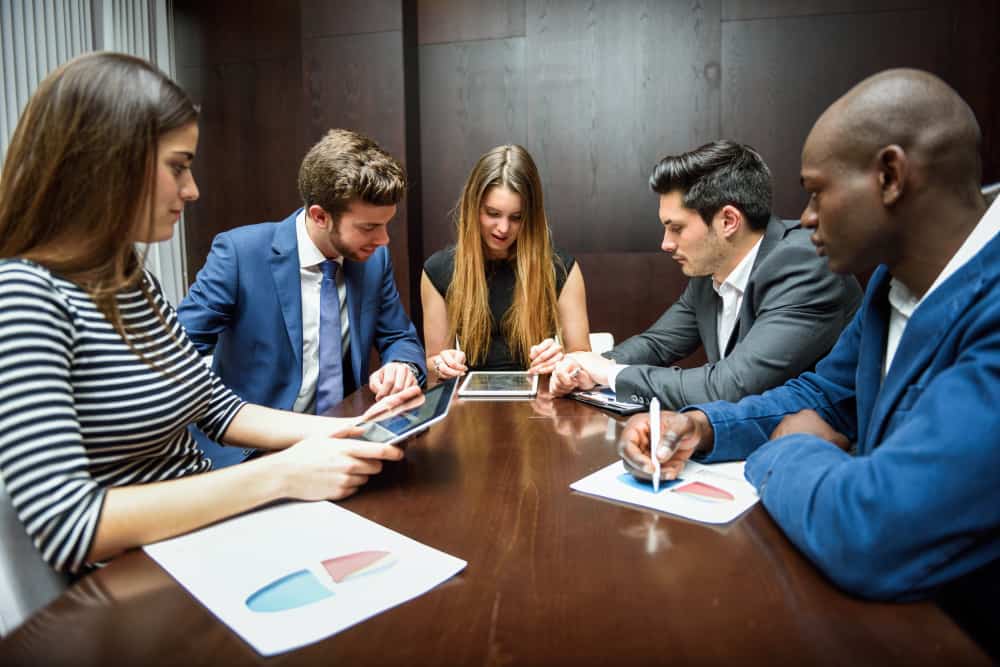Ensuring a great team of employees is vital to the success of any business. Human Resources (HR) and Recruitment have specific roles and responsibilities in helping to build strong teams. They work together to find and retain the best employees for the organization and create an environment where employees feel valued, appreciated, and supported.
HR manages the overall employee experience, from hiring to onboarding to engagement. This job requires HR staff to review resumes, conduct interviews, and assess skills and qualifications. They create and manage policies and procedures for the organization to promote fairness, inclusion, and compliance. HR also works to create an atmosphere of trust and respect for all employees.

Recruitment works alongside HR, has strong relationships and fosters effective partnerships. Recruitment staff identify, assess and select talent for the acquisition of new team members. They use analytics, data and technology to assess the skills and qualifications of potential candidates on a variety of different levels. They ensure that the candidate pool is both broad and diverse. Recruitment also streamlines the onboarding process and helps to reserve the best and most qualified people for the job.
When HR and Recruitment work together, it helps to create a positive work environment, boosts employee engagement and promotes profitability. They understand the importance of delivering the right people for the job and crafting an appropriate culture and environment. When HR and Recruitment collaborate, they are able to identify talented and passionate people and build strong teams that share the same values, goals, and commitment to the organization.
Table of Contents
ToggleGetting The Most Out Of Your HR And Recruitment
HR and recruitment are essential elements of a successful company, as they ensure that the right people are hired and that they are developed and kept engaged. To get the most out of your HR and recruitment processes, there are a few steps that you can take.
First, ensure that you have an effective recruitment strategy in place. This should involve ensuring that you source the right candidates and that they have the skills and experience required for the role. You should also consider using different recruitment methods such as online job postings or social media recruitment, to reach a wider audience.
Second, ensure that your HR processes are efficient and effective. This includes having effective hiring and onboarding processes in place, as well as implementing a system of performance management, feedback and development.
Third, build a good working relationship with your staff. This involves communicating openly and providing effective support and guidance on any issues they may have.
Finally, ensure you are staying up-to-date with current trends and regulations. This includes understanding changes in employment law, learning about the latest recruitment technologies, and using the latest HR best practices.
Overall, the key thing is to ensure you are investing enough time and effort into your HR and recruitment process to get the most out of it. By doing this, you can ensure that you are hiring the best people, creating an engaged and satisfied workforce, and successfully managing your workforce.
Hirebee understands the importance of HR and recruitment, which is why it has automated various tedious tasks like candidate sourcing and candidate screening. As a hiring software for startups, it helps growing businesses focus more on strategic goals and less on manual processes.
How You Can Build Stronger Teams With HR And Recruitment
Focus On an Improved Onboarding Experience During Talent Acquisition
HR and recruitment teams should focus on an improved onboarding experience during talent acquisition in order to promote a successful onboarding and retention cycle. With an improved onboarding experience, new employees come in with a better understanding of the company’s values, culture and expectations, as well as a better understanding of their individual role. The onboarding and recruitment process should also set the stage for ongoing development and learning.

An improved onboarding experience should be tailored to each individual employee, highlighting their unique strengths, needs, and goals. Recruitment teams should create an onboarding journey that involves clearly defined goals, activities and timelines. This includes creating a clear induction program with job descriptions and expectations that are tailored to the specific role and position. Additionally, HR should provide employees with resources required for work and development such as handbooks, tutorials, and software.
Before and after the new hire is onboarded, the HR and recruitment team should provide ongoing support and communication in order to create an engaging environment that promotes retention and development. This includes providing helpful feedback and access to mentors, training, and resources to new employees in order to help them better understand the company and culture, as well as to facilitate the transition into their role.
In conclusion, HR and recruitment teams should focus on an improved onboarding experience to create a smooth transition into the company and promote both retention and development. By creating an onboarding experience that is tailored to each individual, as well as ongoing communication and support, employees will be engaged and likely to make a positive contribution to the organization.
Focus More On Employee Retention
Employee retention is one of the key determinants of a successful organization. HR and recruitment teams should focus on employee retention as much as, or more than their focus on recruitment. This is because keeping existing employees motivated, engaged and developed is an important strategy for reducing turnover and creating a strong organizational culture.
Retention strategies should focus on creating an environment where employees feel valued and respected and work is meaningful. The company should maintain an open dialogue with employees, soliciting feedback to assess whether they are satisfied and happy with their job. Offering competitive compensation, flexible work schedules, and opportunities for professional advancement can also foster employee loyalty. It is also important to support employee personal and professional development with training and continuing-education opportunities.
Implementing a rewards and recognition program can also be beneficial. It can encourage employees to stay with the company and become even more engaged in their work. Team building and morale-building activities are another great way to encourage camaraderie and collaboration amongst employees.
HR and recruitment teams should also consider employees’ work-life balance. Offering work from home options, flexible hours, and vacation days can show employees the company values their work-life balance and is committed to helping them maintain it.
Ultimately, HR and recruitment teams should focus more on employee retention in order to create an environment where employees feel satisfied, engaged, and valued. Doing this will not only improve the quality of the organization’s workforce, but also increase loyalty and satisfaction among employees, boosting organizational performance in the long run.
Build Employer Branding Around Employees
Employer branding is a vital strategy for HR and recruitment teams as it helps to enhance an organization’s overall recruitment process, as well as improve employee morale, engagement and productivity. Employer branding should focus on showcasing an organization’s culture, values and goals in order to attract, engage and retain the right talent. Building employer branding around employees is key to ensure that potential and current employees find the organisation attractive and want to work there.

There are several key methods for HR and recruitment teams to build employer branding around employees. One of the most important methods is storytelling – promote stories from employees, management and the team culture itself to illustrate the values and culture of the workplace. This can include sharing case studies, success stories, or featuring employees on social media to show what makes the organization unique and approachable. Additionally, HR teams should ensure that job postings are up to date, relevant and optimized for potential applicants.
It is also important to highlight initiatives that employees have been involved in to showcase their engagement and ‘ownership’ of the organization’s initiatives. Allow employees to provide feedback, ideas and suggestions to improve the organization’s employer branding and overall engagement. Offer more chances for employees to get involved in activities such as workshops, career fairs, customer service and volunteering as well.
The power of employer branding lies within the people who work for the organisation. Building employer branding around employees plays a large role in marketing the organisation’s culture and values, as well as making it more attractive to top talent. With the right strategy, HR and recruitment teams can create a successful employer brand that promotes loyalty among employees and encourages prospective job candidates.
Streamline Performance Management Processes
Performance management processes need to be streamlined in order to maximize efficiency, accuracy, and effectiveness. It is important for HR and recruitment teams to create robust systems that are easy to use, and to consistently evaluate and refine them. Streamlining these processes can help to ensure that recruitment and performance management systems work effectively and save time.
First, processes should be tailored to each company’s needs. Make sure that there is clarity around the roles and responsibilities of the HR and recruitment team and the individual departments in which they are involved. This can help to ensure that decisions are made quickly and accurately, and that expectations are consistently met.
Additionally, communication between the HR and recruitment teams is essential to streamlining the performance management process. Workflows should be designed to ensure that everyone involved understands their roles, and that feedback is consistently shared and tracked. This can help to prevent miscommunications and ensure that the process runs smoothly.
Finally, the HR and recruitment teams should use data and technology to optimize the performance management process. Gathering, collecting, and analyzing data on employee performance can help to identify areas where improvements can be made, while technology can help ensure that processes are streamlined and efficient. Automating certain tasks can help to remove manual labor, while tracking employee performance in real time can allow for quick decision-making and analysis of performance trends.
By streamlining performance management processes, the HR and recruitment teams can ensure that employees receive the feedback and support they need to perform effectively. This will help to create a more effective, efficient, and productive workplace.
Improve Their Succession Planning Capabilities
Succession planning is an essential process for any organization as it helps to ensure continuity of services, production, and leadership. It also helps to ensure that HR and recruitment teams are prepared for any unexpected changes in key personnel, with suitable replacements in place.

HR and recruitment teams can improve their succession planning capabilities by conducting regular assessments to identify potential candidates and make sure they are aware of any potential changes in job requirements or tasks. This allows them to anticipate any transitions and plan accordingly. Secondly, they must maintain a library of current job descriptions and relevant skills so that they can source suitable talent when required. This helps to save time down the line.
Thirdly, it is important for HR and recruiters to keep up with industry trends and ensure that the company’s succession planning strategy is relevant and flexible. It is also essential that they communicate with candidates during the selection process, as this helps to provide clarity and enable them to gain a better understanding of the requirements.
Finally, regular training and development should be provided to those in succession plan roles. This helps to ensure they are up to date with best practices and latest trends. Additionally, it also helps to maintain motivation among current personnel, giving them the confidence that they are being observed and groomed as potential replacements.
All of these initiatives help to ensure that HR and recruitment teams are up to date with succession planning and can stay ahead of the competition. Doing so ensures that the company is always well prepared for any eventuality.
Put Greater Emphasis On Diversity And Inclusion
Diversity and inclusion should be a core focus of HR and recruitment teams. By creating an environment that promotes and celebrates diversity, not only are companies supporting the success and well-being of their employees, but they’re also creating value by reaching a wider range of potential customers, ideas and solutions. For HR and recruitment teams, some concrete steps towards greater inclusion include considering different ethnic backgrounds and cultures in their hiring pools and reviewing job postings for language that could be unintentionally excluding people. In terms of diversity, it’s important to go beyond gender and race, by examining everything from different roles, socio-economic backgrounds, sexual orientations and other traits that could be impacted by society. Training and communication is key for HR and recruitment teams to ensure a positive work environment for everyone. Managers can be trained on unconscious bias and how to be an ally for underrepresented groups, while employees should be provided with support networks to build meaningful relationships across differences. This in turn can build a culture of collaboration and camaraderie between employees. In addition, HR and recruitment teams can introduce policies and practices that support diversity and inclusion, such as offering flexible working arrangements, affirmative action plans and family-friendly initiatives. By investing in the development of an inclusive environment, companies can attract and retain top talent while creating a sense of belonging for everyone. Diversity and inclusion should be taken seriously and given the attention it deserves by HR and recruitment teams.
Give An Ideal Working Environment For Human Capital
Giving an ideal working environment for human capital means creating an environment that provides employees with the resources they need to be successful in their jobs and develop their skills while also meeting the company’s goals. To create an ideal working environment, employers should focus on creating an open and supportive environment that encourages collaboration, creativity, and innovation. This can be achieved through open dialogue between management and staff, providing meaningful feedback, things like flex time and work from home policies, competitive salaries, and enabling career development.
Flexible scheduling should also be considered to help employees achieve a healthy work-life balance. By providing employees with the ability to modify their schedules to accommodate personal situations and needs, employers demonstrate their commitment to a healthy working environment. Businesses should also provide training opportunities so employees can stay up-to-date with the latest technology and industry trends. Additionally, offering educational programs and promoting continuing education can help employees develop their skills and sharpen their competitive edges.
To create an ideal working environment, HR and recruitment teams should also focus on building positive and meaningful relationships with employees. This includes creating strong communication channels, where all employees feel heard and included. Furthermore, employers should build a culture of recognition, featuring rewards and incentives for exceptional employees or teams, creating increased motivation and job satisfaction among the staff. Ultimately, it’s up to HR and recruitment teams to ensure that all employees are supported and empowered to bring their best selves to work every day.
Conclusion
Human Resources (HR) and Recruitment departments work in tandem to build strong teams. Through the recruitment process, HR professionals can identify individuals with the right skills, knowledge and experience to move the organization forward.
At the same time, HR professionals can use their understanding of the organizational culture and environment to ensure that the right recruits are selected and the new hires fit in. With the assistance of an effective recruitment strategy, HR professionals can ensure that the right people are identified, attracted and recruited for each position.
This leads to increased productivity, greater employee engagement and lower turnover, which are all essential components of a successful team. Through supportive structures and effective communication, HR and Recruitment teams can play an important role in the success of an organization.









